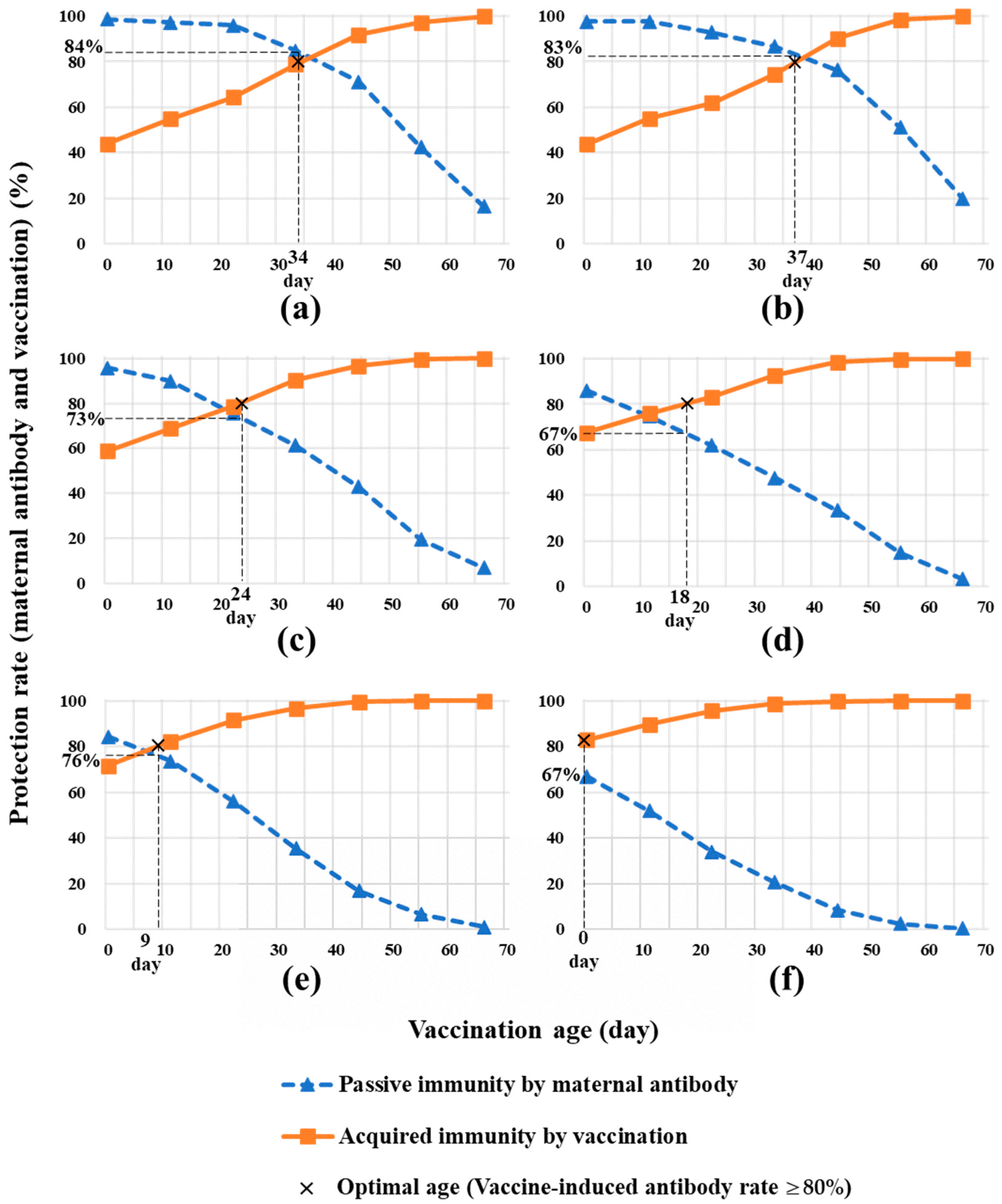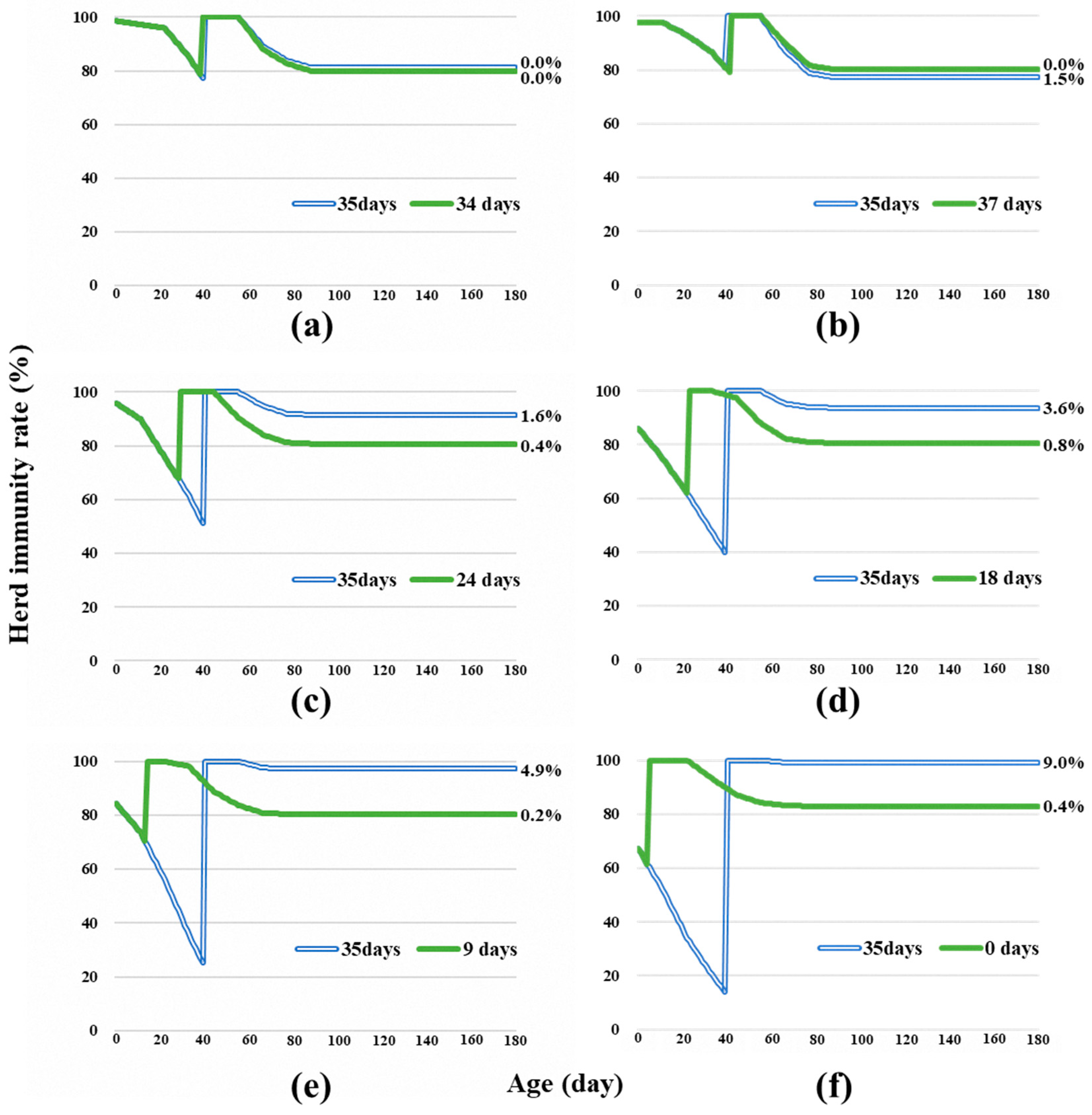Evaluation of Immune Status of Pigs against Classical Swine Fever for Three Years after the Initiation of Vaccination in Gifu Prefecture, Japan
Abstract
1. Introduction
2. Materials and Methods
2.1. Serum Samples
2.2. Pig Herd Vaccination
2.3. Antibody Detection Methods
2.4. Classification of Sows and Sequential Evaluation of Antibody Levels
2.5. Sequential Evaluation of Antibody Levels in Fattening Pigs
2.6. Estimation of Optimal Age for Vaccination
2.7. Evaluation of Risk of CSF Infection in Fattening Pig Herds
3. Results
3.1. Investigation of Antibody Distribution in Sows
3.2. Investigation of Vaccine-Induced Antibodies in Fattening Pigs
3.3. Estimation of Optimal Age for Vaccination and Risk of CSF Infection in Fattening Pig Herds
4. Discussion
5. Conclusions
Supplementary Materials
Author Contributions
Funding
Institutional Review Board Statement
Informed Consent Statement
Data Availability Statement
Acknowledgments
Conflicts of Interest
References
- International Committee on Taxonomy of Viruses (ICTV). Virus Taxonomy: The ICTV Report on Virus Classification and Taxon Nomenclature, Family: Flaviviridae Genus: Pestivirus. Available online: https://ictv.global/report/chapter/flaviviridaeport/flaviviridaeport/flaviviridae/pestivirus (accessed on 28 May 2024).
- Shimizu, Y.; Furuuchi, S.; Kumagai, T.; Sasahara, J. A mutant of hog cholera virus inducing interference in swine testicle cell cultures. Am. J. Vet. Res. 1970, 31, 1787–1794. [Google Scholar] [PubMed]
- Shimizu, Y. Eradication of classical swine fever in Japan. Bull. Natl. Inst. Anim. Health. 2013, 119, 1–9. Available online: https://www.naro.go.jp/publicity_report/publication/archive/files/119-01.pdf (accessed on 28 May 2024).
- World Organisation for Animal Health (WOAH). Japan Suspension of CSF-Free Status. Available online: https://bulletin.woah.org/?officiel=11-1-4-japan-suspension-of-csf-free-status&edition=6871&pdf=officiel&article=5608 (accessed on 28 May 2024).
- Postel, A.; Nishi, T.; Kameyama, K.I.; Meyer, D.; Suckstorff, O.; Fukai, K.; Becher, P. Reemergence of classical swine fever, Japan, 2018. Emerg. Infect. Dis. 2019, 25, 1228–1231. [Google Scholar] [CrossRef] [PubMed]
- Hayama, Y.; Shimizu, Y.; Murato, Y.; Sawai, K.; Yamamoto, T. Estimation of infection risk on pig farms in infected wild boar areas– Epidemiological analysis for the reemergence of classical swine fever in Japan in 2018. Prev. Vet. Med. 2020, 175, 104873. [Google Scholar] [CrossRef] [PubMed]
- Ministry of Agriculture, Forestry and Fisheries, Japan (MAFF). Status of Classical Swine Fever Outbreaks and Vaccination for Domestic Pigs. Available online: https://www.maff.go.jp/j/syouan/douei/csf/attach/pdf/domestic-35.pdf (accessed on 28 May 2024).
- Ministry of Agriculture, Forestry and Fisheries, Japan (MAFF). Information on the Surveillance of Classical Swine Fever in Wild Boars. Available online: https://www.maff.go.jp/j/syouan/douei/csf/wildboar_map.html (accessed on 28 May 2024).
- Ministry of Agriculture, Forestry and Fisheries, Japan (MAFF). Action on Prevention of Epidemic of Classical Swine Fever (Summary). Available online: https://www.maff.go.jp/j/syouan/douei/csf/domestic.html (accessed on 6 June 2024).
- Yamamoto, T. Current situation of CSF outbreak in Japan from epidemiological perspective. Proc. Jpn. Pig. Vet. Soc. 2022, 79, 1–7. Available online: https://tonbyo.com/proceedings/2009.html (accessed on 23 July 2024).
- Chase, C.; Lunney, J.K. Immune system. In Diseases of Swine, 11th ed.; Zimmerman, J.J., Karriker, L.A., Ramirez, A., Schwartz, K.J., Stevenson, G.W., Eds.; Wiley-Blackwell/American Association of Swine Veterinarians: Hoboken, NJ, USA, 2019; pp. 264–291. [Google Scholar] [CrossRef]
- Fukusho, A. Eradication of Classical Swine Fever and Future Countermeasures. Available online: https://warp.ndl.go.jp/info:ndljp/pid/235118/niah.naro.affrc.go.jp/sat/sishocho/Fukusho/tonko_bokumetu.htm (accessed on 28 May 2024).
- Ogawa, T.; Hatakeyama, H.; Uchimura, A.; Kawamura, H.; Fukusho, A.; Shimizu, Y. Statistical analysis on distribution of hog cholera virus antibody titers in Japan. Bull. Natl. Inst. Anim. Health. 1984, 86, 1–7. Available online: https://agriknowledge.affrc.go.jp/RN/2010291652 (accessed on 28 May 2024).
- Kirkland, P.D.; Potier, M.-F.L.; Finlaison, D. Pestiviruses. In Diseases of Swine, 11th ed.; Zimmerman, J.J., Karriker, L.A., Ramirez, A., Schwartz, K.J., Stevenson, G.W., Eds.; Wiley-Blackwell/American Association of Swine Veterinarians: Hoboken, NJ, USA, 2019; pp. 622–640. [Google Scholar]
- Sakoda, Y. Development of Novel Diagnostic Methods of Classical Swine Fever. Ph.D. Thesis, Hokkaido University, Sapporo, Japan, 1999. Available online: https://eprints.lib.hokudai.ac.jp/dspace/bitstream/2115/32737/1/5508.pdf (accessed on 28 May 2024).
- Ukita, M.; Kuwata, K.; Tanaka, E.; Matsuyama, R.; Isoda, N.; Sakoda, Y.; Yamamoto, T.; Makita, K. Exploring appropriate strategies for vaccination against classical swine fever under a dynamic change in antibody titer in sows after starting vaccination in a Japanese farm setting. Transbound. Emerg. Dis. 2023, 2023, 1–15. [Google Scholar] [CrossRef]
- Sakoda, Y.; Hikawa, M.; Tamura, T.; Fukusho, A. Establishment of a serum-free culture cell line, CPK-NS, which is useful for assays of classical swine fever virus. J. Virol. Methods. 1998, 75, 59–68. [Google Scholar] [CrossRef] [PubMed]
- Sakoda, Y.; Wakamoto, H.; Tamura, T.; Nomura, T.; Naito, M.; Aoki, H.; Morita, H.; Kida, H.; Fukusho, A. Development and evaluation of indirect enzyme-linked immunosorbent assay for a screening test to detect antibodies against classical swine fever virus. Jpn. J. Vet. Res. 2012, 60, 85–94. [Google Scholar] [CrossRef] [PubMed]
- Kuwata, K.; Ukita, M.; Kato, S.; Kuninaga, N.; Tanaka, E.; Sakoda, Y.; Makita, K. Development of a model for estimating the optimal age for classical swine fever vaccination. J. Jpn. Vet. Med. Assoc. 2023, 76, e274–e282. [Google Scholar] [CrossRef]
- Graham, S.P.; Everett, H.E.; Haines, F.J.; Johns, H.L.; Sosan, O.A.; Salguero, F.J.; Clifford, D.J.; Steinbach, F.; Drew, T.W.; Crooke, H.R. Challenge of pigs with classical swine fever viruses after C-strain vaccination reveals remarkably rapid protection and insights into early immunity. PLoS ONE 2012, 7, e29310. [Google Scholar] [CrossRef]
- Kure, K. Verification by JASV regarding the 64th, 65th and 67th cases of classical swine fever in Japan and the recommendations to prevent the occurring in pig farms anymore. Proc. Jpn. Pig. Vet. Soc. 2022, 79, 26–29. Available online: https://tonbyo.com/proceedings/2009.html (accessed on 23 July 2024).
- Terpstra, C.; Wensvoort, G. The protective value of vaccine-induced neutralising antibody titres in swine fever. Vet. Microbiol. 1988, 16, 123–128. [Google Scholar] [CrossRef]
- Van Oirschot, J.T. Vaccinology of classical swine fever: From lab to field. Vet. Microbiol. 2003, 96, 367–384. [Google Scholar] [CrossRef] [PubMed]
- Li, H.; Yang, H. Infection of porcine reproductive and respiratory syndrome virus suppresses the antibody response to classical swine fever virus vaccination. Vet. Microbiol. 2003, 95, 295–301. [Google Scholar] [CrossRef] [PubMed]
- Suradhat, S.; Kesdangsakonwut, S.; Sada, W.; Buranapraditkun, S.; Wongsawang, S.; Thanawongnuwech, R. Negative impact of porcine reproductive and respiratory syndrome virus infection on the efficacy of classical swine fever vaccine. Vaccine 2006, 24, 2634–2642. [Google Scholar] [CrossRef] [PubMed]
- Huang, Y.L.; Pang, V.F.; Lin, C.M.; Tsai, Y.C.; Chia, M.Y.; Deng, M.C.; Chang, C.Y.; Jeng, C.R. Porcine circovirus type 2 (PCV2) infection decreases the efficacy of an attenuated classical swine fever virus (CSFV) vaccine. Vet. Res. 2011, 42, 115. [Google Scholar] [CrossRef] [PubMed]
- Chen, J.Y.; Wu, C.M.; Liao, C.M.; Chen, K.C.; You, C.C.; Wang, Y.W.; Huang, C.; Chien, M.S. The impact of porcine circovirus associated diseases on live attenuated classical swine fever vaccine in field farm applications. Vaccine 2019, 37, 6535–6542. [Google Scholar] [CrossRef] [PubMed]



| Generation of Sows | No. of Sows in Each Period 1 | Total No. | |||||
|---|---|---|---|---|---|---|---|
| 2020-First | 2020-Second | 2021-First | 2021-Second | 2022-First | 2022-Second | ||
| SOW-G1 | 73 | 102 | 91 | 120 | 81 | 20 | 487 |
| SOW-G1.5 | 0 | 22 | 75 | 64 | 48 | 18 | 227 |
| SOW-G2 | 0 | 3 | 51 | 189 | 235 | 260 | 738 |
| Ratio of SOW-G2 in Total 2 (%) | 0 | 2.4 | 23.5 | 50.7 | 64.6 | 87.2 | 50.8 |
| Antibody Titer in Each Period 1 (log2) | Antibody Titer in Each Generation (log2) | |||||||||
|---|---|---|---|---|---|---|---|---|---|---|
| 2020 | 2021 | 2022 | ||||||||
| SOW-G1 | SOW-G1.5 | SOW-G2 | ||||||||
| First | Second | First | Second | First | Second | |||||
| Mean | 9.1 | 9.2 | 7.9 | 7.1 | 6.6 | 5.4 | 8.4 | 7.5 | 6.0 | |
| Median | 9 | 10 | 8 | 7 | 7 | 6 | 9 | 8 | 6 | |
| Mode | 9 | 10 | 9 | 9 | 7 | 6 | 9 | 9 | 6 | |
| SD | 1.6 | 1.7 | 1.9 | 2.4 | 2.1 | 2.3 | 1.8 | 2.1 | 2.4 | |
| Term 1 | Farm No. | Average Vaccination Age (Day) | Pig No. | ELISA- Positive Rate (%) | Vaccine-Induced Antibody Rate 2 (%) | Mean Antibody Titer 3 (log2) | Farm No. with ≥80% Antibody- Positive Rate |
|---|---|---|---|---|---|---|---|
| 2020- second | 14 | 42.4 [35–60] 4 | 401 | 71.2 [46.5–100] 4 | 90.2 [78.6–100] 4 | 5.5 [3.0–10.0] 4 | 13/14 |
| 2021- first | 16 | 47.1 [31–60] | 397 | 72.5 [33.3–100] | 97.1 [84.6–100] | 5.5 [2.6–10.5] | 16/16 |
| 2021- second | 14 | 42.4 [33–51] | 292 | 58.8 [15.0–90.0] | 92.7 [85.0–100] | 4.1 [1.3–6.7] | 14/14 |
| 2022- first | 15 | 39.5 [20–50] | 302 | 67.3 [50.0–85.0] | 93.6 [85.7–100] | 4.8 [3.6–6.6] | 15/15 |
| 2022- second | 21 | 37.9 [28–60] | 590 | 56.9 [22.7–100] | 91.0 [72.7–100] | 4.1 [1.8–7.5] | 19/21 |
Disclaimer/Publisher’s Note: The statements, opinions and data contained in all publications are solely those of the individual author(s) and contributor(s) and not of MDPI and/or the editor(s). MDPI and/or the editor(s) disclaim responsibility for any injury to people or property resulting from any ideas, methods, instructions or products referred to in the content. |
© 2024 by the authors. Licensee MDPI, Basel, Switzerland. This article is an open access article distributed under the terms and conditions of the Creative Commons Attribution (CC BY) license (https://creativecommons.org/licenses/by/4.0/).
Share and Cite
Kuwata, K.; Kuninaga, N.; Kimura, Y.; Makita, K.; Isoda, N.; Shimizu, Y.; Sakoda, Y. Evaluation of Immune Status of Pigs against Classical Swine Fever for Three Years after the Initiation of Vaccination in Gifu Prefecture, Japan. Pathogens 2024, 13, 616. https://doi.org/10.3390/pathogens13080616
Kuwata K, Kuninaga N, Kimura Y, Makita K, Isoda N, Shimizu Y, Sakoda Y. Evaluation of Immune Status of Pigs against Classical Swine Fever for Three Years after the Initiation of Vaccination in Gifu Prefecture, Japan. Pathogens. 2024; 13(8):616. https://doi.org/10.3390/pathogens13080616
Chicago/Turabian StyleKuwata, Keisuke, Naotoshi Kuninaga, Yoko Kimura, Kohei Makita, Norikazu Isoda, Yukio Shimizu, and Yoshihiro Sakoda. 2024. "Evaluation of Immune Status of Pigs against Classical Swine Fever for Three Years after the Initiation of Vaccination in Gifu Prefecture, Japan" Pathogens 13, no. 8: 616. https://doi.org/10.3390/pathogens13080616
APA StyleKuwata, K., Kuninaga, N., Kimura, Y., Makita, K., Isoda, N., Shimizu, Y., & Sakoda, Y. (2024). Evaluation of Immune Status of Pigs against Classical Swine Fever for Three Years after the Initiation of Vaccination in Gifu Prefecture, Japan. Pathogens, 13(8), 616. https://doi.org/10.3390/pathogens13080616






